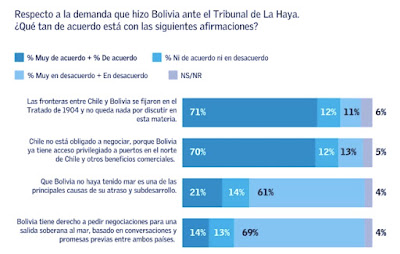Chile has a complex conflict related to Bolivia's sovereign access to the Pacific Ocean.
It is not a conventional case of border limits. The objective of the Bolivian demand before the International Court of Justice is to make Chile accept a dialogue to give Bolivia a sovereign exit to the Pacific Ocean.
In recent years, the Chilean-Bolivian political relations show a tense atmosphere, that neither the political tendencies of the same sign have served to advance a solution to the case.
The facilities that Bolivia has to access the sea
After the War of the Pacific and with the signing of the Treaty of 1904, Bolivia loses all possibility of sovereign access to the Pacific Ocean; however, from that moment, Chile has given different facilities to Bolivia to access the sea.
In the world there are 47 Mediterranean countries and in the case of Bolivia, the benefits granted by Chile are the most advantageous. Chile has been concerned to maintain in good condition the road routes that unite it with Bolivia among many other benefits for its international trade.
Comparative analysis
Access roads to the coast
- Chile has taken care to maintain the road routes that connect it with Bolivia in good maintenance status, unlike other transit countries that have not had the same consideration with the mediterranean ones.
- In the case of the railways, Chile financed the construction of the Arica / La Paz Railroad and transferred the Bolivian section without cost and is currently repairing it through a private company, which has been subsidized by the State itself.
- The distances between Bolivia and the Chilean ports of Arica and Antofagasta and the Peruvians of Matarani and Ilo are at least half that of the ports of the Atlantic.
- Only Switzerland has better roads and rail network at its disposal, but in no case built specifically to solve its problem.
Border crossings
- Between Chile and Bolivia there are five border crossings, which are surpassed by 12 existing between India and Bhutan, but considering the geography of our border and since Bolivia only uses two Chilean ports, it is not necessary to implement more border crossings.
- The waiting time in Chile of two hours is reduced in comparison with other South American countries, however, Switzerland has eliminated border controls with the European Union (EU), disappearing the costs of waiting or customs taxes.
- Chile could reduce the waiting time more by simplifying and homologation of the immigration documentation between both countries.
Use of ports
- Chile grants Bolivia the widest use of all its ports; Of which they onlyuse Arica and Antofagasta, the customs franchises in these ports are the most extensive granted in South America and also grants a subsidy to Bolivian cargo rates, a benefit that no other country grants. All the South American countries grant Bolivia and Paraguay spaces for cargo storage in or near ports.
- Although Peru and Argentina have assigned Bolivia land (without sovereignty) for the construction of port facilities, the latter has not materialized. Chile for its part has not granted this facility to Bolivia.
Free Transit
- All countries included in the study give freedom of transit to the mediterranean countries.
Commercial exchange and bilateral relations
- As it has been seen in the cases of Switzerland and Bhutan, the excellent relations with the EU and with India have allowed them to obtain important benefits. Switzerland has managed to eliminate border controls with the EU and sign a Free Trade Agreement. For its part, Bhutan has obtained important benefits for the import and export of its products from Indian ports.
- On the other hand, given the bad bilateral relations between Nepal and India, it has not been able to obtain facilities to trade its products, despite the fact that, due to its rugged geography, it is the only possibility to have access a port and be able to export their products.
BOLIVIA HAS ACCESS TO THE SEA THIS IS AN UNDENIABLE FACT
Under the Treaty of Peace and Friendship of 1904, Chile recognized in favor of Bolivia and in perpetuity "the broadest and freest right of commercial transit through its territory and Pacific ports". Along with this, Bolivia enjoys customs autonomy, tariff preferences and storage facilities, tax exemptions and free movement along the connection routes with the ports. These benefits arise from the Treaty of 1904 and from different instruments signed between both States. Through these facilities, privileges and rights in Chilean territory, Bolivia has broad access to the Pacific Ocean.
CUSTOMS AUTONOMY OF BOLIVIA IN THE PORTS OF ARICA AND ANTOFAGASTA
As a consequence of the Treaty of 1904, Bolivia exercises customs authority in the ports of Arica and Antofagasta over cargoes bound for Bolivia. This implies that Bolivia has its own customs authorities in the ports of Arica and Antofagasta. It is the said authorities and not the Chilean ones that issue or authorize the documentation related to said cargo for dispatch to Bolivia. And it means, in addition, that Bolivia has the discretion to dictate its own tariffs and set the rate of import duties, among other measures. The ability to have own customs authorities in Chilean ports is a distinctive element that Bolivia has and that is not applied in the case of other landlocked countries.
RIGHT OF BOLIVIAN CARGOES TO REMAIN STORED FOR SUBSTANTIALLY LARGER DEADLINES
Bolivian goods in transit can remain in the primary zones of the ports of Arica and Antofagasta for a period of one year under the Bolivian customs authority. This period may be extended for three more months (90 days) under Chilean customs authority. That is, the Bolivian merchandise can be 1 year and 3 months in the primary zones of the mentioned Chilean ports (455 days). In those same areas, Chilean or third-country goods can only remain three months (90 days), a term at which they fall under the presumption of abandonment, and must pay fines to obtain their recovery.
FREE STORAGE
Bolivia enjoys free storage in the ports of Arica and Antofagasta for up to one year for its imports and up to 60 days for its exports. This free storage does not exist for Chilean or third country cargoes. The free storage in favor of the Bolivian cargo exceeds the obligations of free transit predicted in the 1904 Treaty, as well as the standards of international law.
PREFERENTIAL RATES FOR THE USE OF DOCK FOR FIO CARGO
There is a flat fee of USD 0.85 per ton, which applies to all Bolivian goods whose freight rates have been agreed under FIO conditions (Free in and out, the cost of the freight is from the freight contractor) or, the goods in which the payment of the service of loading and / or unloading is of the consignee. This reduced rate does not apply to Chilean or third-country cargoes: for the same service, they must currently pay USD 1.98 per ton in the port of Arica.
TAX EXEMPTION TO ALL SERVICES APPLIED TO CARGOES IN TRANSIT
Chilean legislation exempts from all taxes that may affect cargo coming from or destined to Bolivia in free transit through Chilean territory and ensures the exemption of Value Added Tax (VAT) to all services rendered to that cargo.
BOLIVIA HAS A PORT
More than 7 thousand Bolivian companies carry out their foreign trade through Chilean ports. In the last five years, the movement of Bolivian trade cargo by Chilean ports increased by 132%. As of December 2015, 80% of the cargo moved by the port of Arica corresponded to Bolivian cargo. Bolivia has other facilities to access the Pacific and Atlantic Oceans, under agreements signed with countries in the region. However, a high percentage of its foreign trade is made through the Port of Arica, confirming its effective access to the sea and its preference for Chilean ports.
HOW MUCH DOES IT COST CHILE?
The set of benefits and privileges of free transit available to Bolivia cost Chile about USD 100 million per year. This, without considering the investments that Chile has had to make from time to time to expand and improve the port, customs, road and railway infrastructure, which significantly increases the amounts indicated.
FAVORABLE TRADE TO BOLIVIA
Finally, of the multiple trade agreements that Chile has signed, the only one that was negotiated asymmetrically, that is, agreeing to clearly grant more than what has been received, is the Agreement of Economic Complementation with Bolivia. While Chile granted a 0% tariff to all Bolivian products (except for sugar in excess of 6,000 tons), Bolivia only granted 0% tariff to 300 Chilean products.
SICA SICA PIPELINE - ARICA
Free transit has a particular expression in the Sica Sica - Arica pipeline. Chile granted Bolivia a concession for the use of two plots of land in Arica, one of 13 hectares and another of 3.5 hectares, destined to the operation and transfer of hydrocarbons that would be exported through the pipeline. Likewise, a strip of land for the pipeline from Arica to the border of 10 meters wide and more than 150 kilometers long, with an area exceeding 150 hectares, was granted in concession of use. By a 1992 agreement, Chile allows the use in both directions of the pipeline and fuel storage, leaving those facilities suitable for export and import thereof. In other words ... BOLIVIA HAS ACCESS TO THE SEA.
Conclusions
Chile grants Bolivia more than what is established in International Law towards landlocked countries to facilitate their access to the sea.
There is no Mediterranean country in the world that receives all the facilities that Chile grants to Bolivia.
In spite of the great amount of benefits that Bolivia receives from Chile, to have access to the coast, when compared with what other States grant to landlocked countries, it is appreciated that it could be improved in:
- Mutual trust and bilateral relations, which would allow progress towards greater and better benefits for Bolivia, such as achieving a Free Trade Agreement.
- Reduce the time it takes to carry out border procedures between both countries, and perhaps in the future eliminate controls.
- Cede non-sovereign land for Bolivia to build its own port facilities.
Finally, it is concluded that Chile grants more facilities to Bolivia to access the sea that any other State grants to a Mediterranean country in similar circumstances, even before the International Law in relation to this matter.
What do Chileans currently think about the conflict?
The last national measurement (UC - GFK Adimark), carried out in mid July 2018, registered the following results.
With regard to the maritime demand of Bolivia, and before the question: How strongly do you agree with the following statements?
71% of the respondents answered that the borders between Chile and Bolivia were fixed in the 1904 Treaty and nothing remains to be discussed on this issue.
70% of respondents think that Chile is not obliged to negotiate because Bolivia already has privileged access to ports in northern Chile.
61% do not believe that Bolivia has not had sea is one of the main causes of its delay and underdevelopment
69% of the respondents do not think that Bolivia has the right to request negotiations for a sovereign exit to the sea based on previous talks and promises between both countries.
The Chilean Chancellery in February 2018 published the video "Chile and the Bolivian Maritime Aspirations" which explains in detail the current conditions of compliance of the current treaty of 1904.
Source of information
Ministry of Foreign Affairs
Marina Magazine - Carlos González M.
UC-GFK Adimark






